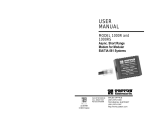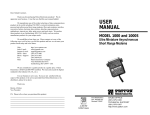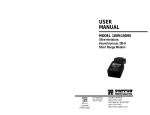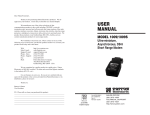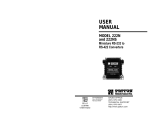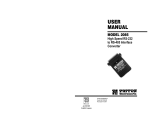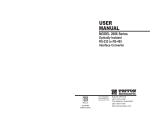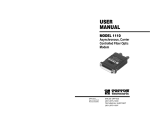Download USER MANUAL - GMI
Transcript
USER M A N UA L MODEL 2017A RS-232 to 20ma Current Loop Converter Part# 07M2017A-A Doc# 073021UA Revised 10/15/93 SALES OFFICE (301) 975-1000 TECHNICAL SUPPORT (301) 975-1007 http://www.patton.com 1.0 WARRANTY INFORMATION 2.0 GENERAL INFORMAT I O N Patton Electronics warrants all Model 2017A components to be free from defects, and will—at our option—repair or replace the product should it fail within one year from the first date of shipment. Thank you for your purchase of this Patton Electronics product. This product has been thoroughly inspected and tested and is warranted for One Year parts and labor. This warranty is limited to defects in workmanship or materials, and does not cover customer damage, abuse, or unauthorized modification. If this product fails or does not perform as warranted, your sole recourse shall be repair or replacement as described above. Under no condition shall Patton Electronics be liable for any damages incurred by the use of this product. These damages include, but are not limited to, the following: lost profits, lost savings, and incidental or consequential damages arising from the use of or inability to use this product. Patton Electronics specifically disclaims all other warranties, expressed or implied, and the installation or use of this product shall be deemed an acceptance of these terms by the user. If any questions or problems arise during installation or use of this product, please do not hesitate to contact Patton Electronics Customer Service at (301) 975-1007. 1.1 RADIO AND TV INTERFERENCE The Model 2017A generates and uses radio frequency energy, and if not installed and used properly—that is, in strict accordance with the manufacturer's instructions—may cause interference to radio and television reception. If the Model 2017A does cause interference to radio or television reception, which can be determined by disconnecting the power supply, the user is encouraged to try to correct the interference by one or more of the following measures: moving the computing equipment away from the receiver, re-orienting the receiving antenna, and/or plugging the receiving equipment into a different AC outlet (so the computing equipment and receiver are on different branches). 1.2 SERVICE All warranty and non-warranty repairs must be returned freight prepaid and insured to Patton Electronics. All returns must have a Return Materials Authorization number on the outside of the shipping container. This number may be obtained from Patton Electronics Technical Service at (301) 975-1007. Packages received without an RMA number will not be accepted. Patton Electronics' technical staff is also available to answer any questions that might arise concerning the installation or use of your Model 2017A. Technical Service hours: 8AM to 5PM EST, Monday through Friday. 1 2.1 FEATURES • • • • • • • • Full duplex, asynchronous transmission over 4 wires Operates actively or passively (receiver only; transmitter is active) Data rates up to 115,200 bps Range to 4 miles on 24 AWG twisted pair Optically isolated and surge protected LEDs monitor transmit data, receive data and power DB-25 male or female connectors on RS-232 side Twisted pair connection via terminal block with strain relief, RJ-11 jack or RJ-45 jack • External DCE/DTE switch • Made in the USA 2.2 DESCRIPTION The Model 2017A RS-232 to 20mA current loop converter lets an asynchronous RS-232 device communicate with a 20mA current loop device. Equipped with an external power supply, the Model 2017A supports data rates up to 115,200 bps. The Model 2017A transmitter is active and must be connected to a passive receiver, and the Model 2017A receiver can accommodate either a passive transmitter or an active transmitter. Operating full duplex, the Model 2017A supports communication distances up to 4 miles over two unconditioned 24 AWG twisted pair. To guard against data loss due to ground loops, the Model 2017A is equipped with 1500 V RMS optical isolators on the line side. The Patton Model 2017A connects directly to the RS-232 interface using a male or female DB-25 connector. An external DCE/DTE switch eliminates the need for a cross-over cable on the RS-232 interface. The Model 2017A is manufactured in the USA. 2 3.0 CONFIGURAT I O N 3.2 SETTING THE ACTIVE/PASSIVE SWITCH The Model 2017A is easy to use. The only configuration necessary for operation is the proper setting of two switches: the external DCE/DTE switch and the internal active/passive switch. The active/passive switch is used to control the mode of the receiver; it has no control over the transmitter since the transmitter is fixed in the active mode. 3.1 SETTING THE DCE/DTE SWITCH Figure 1 shows the location of the DCE/DTE switch on the PC board, as well as the location of the terminal block and surge suppressors. Active/passive Switch DCE/DTE Switch To configure your Model 2017A receiver, you first need to determine whether your device will be active or passive. If you are going to use the Model 2017A receiver to source current for the loop, set the switch to the “active” position. If the Model 2017A is to be used in an active loop, set the Model 2017A receiver’s active/passive switch to passive. WARNING: Never connect two active devices together. Your configuration must be "active to passive" or "passive to active". TX Terminal Block RCV PWR Active Active/Passive Switch AC Adapter RCV G XMT + - - + Figure 1. The Model 2017A Passive For your convenience, the Model 2017A has an externally accessible DCE/DTE switch (see figure 2). If the RS-232 device connected to the Model 2017A is a modem or multiplexer (or is wired like one), set the switch to "DTE". This setting causes the Model 2017A to behave like Data Terminal Equipment, transmitting data on RS-232 pin 2 and receiving data on pin 3. DCE Figure 3. The active/passive switch DTE Figure 2. The DCE/DTE switch If the RS-232 device connected to the Model 2017A is a PC, terminal or host computer (or is wired like one), set the switch to "DCE". This setting causes the Model 2017A to behave like Data Communications Equipment, transmitting data on RS-232 pin 3 and receiving data on pin 2. Remember: The switch setting is always from the point of view of the Model 2017A, not the connected equipment. 3 4 4.0 INSTA L L AT I O N The Model 2017A is simple to install. After configuring the DCE/DTE and active/passive switches, connect the two twisted pairs using the following instructions. 4.1 TWISTED PAIR WIRING OVERVIEW Only one Model 2017A is needed for each RS-232 to 20mA current loop circuit. The Model 2017A is connected to the current loop device using two twisted pairs. The pairs must be dry, unconditioned metallic wire, 19-26 AWG. Best distance is achieved with smaller gauges (i.e., thicker wires). When you have completed wiring for your data circuit, the pin connections should be as shown below: XMT XMT G RCV RCV 4.1.1 + To Shield (Optional) + RCV+ RCV G XMT XMT + } One Pair } One Pair TWISTED PAIR CONNECTION USING TERMINAL BLOCKS Once the unit has been opened, you will be able to see the terminal blocks located at the rear of the PC board. 2. Strip the outer insulation from the twisted pairs about one inch from the end. 3. Strip back the insulation on each of the 2 twisted pair wires about .25". The terminal block/strain relief version of the Model 2017A allows you to hook up the line side interface using bare wires. The following instructions will tell you how to open the case, connect the bare wires, and fasten the strain relief collar in place. 1. Open the unit by gently inserting a screw driver between the DB-25 connector and the lip of the plastic case (see below). You don't have to worry about breaking the plastic, but be careful not to bend the D-sub connector. 4. Connect one pair of wires in the telephone cable to "XMT" (Transmit) on the terminal block, being careful to observe the polarity. (The wire connected to "XMT+" must be connected at the other end of the telephone line to "RCV+" in the other unit and the wire connected to "XMT-" must be connected at the other end of the telephone line to "RCV-" in the other unit). 5. Connect the other pair of wires in the telephone cable to "RCV" (Receive), again being careful to observe the polarity. (The wire connected to "RCV+" must be connected at the other end of the telephone line to "XMT+" in the other unit and the wire connected to "RCV-" must be connected at the other end of the telephone line to "XMT-" in the other unit). 5 6 6. If there is a shield around the telephone cable, it may be connected to "G" on the terminal block. To avoid ground loops, we recommend connecting the shield at the computer end only. A ground wire is not necessary for proper operation of these units. 9. Insert the strain relief assembly with the wire going through it into the slot in the bottom half of the converter case and set it into the recess in the case. If the telephone wire does not fit, please contact our technical support. We have gauges to accommodate most wire diameters. 7. When you finish connecting the wires to the terminal block, the assembly should resemble the diagram below: +RCV- G -XMT+ +RCV- G -XMT+ 8. Place the 2 halves of the strain relief assembly on either side of the telephone wire and press together very lightly. Slide the assembly so that it is about 2 inches from the terminal posts and press together firmly. If your cable diameter is too small or too large for our strain relief, please contact our technical support. We have strain relief assemblies to accommodate most cable diameters. 10. BEND the top half of the case as necessary to place it over the strain relief assembly. Do not snap the case together yet. +RCV- G -XMT+ 11. Insert one captive screw through a saddle washer; then insert the captive screw with the washer on it through the hole in the DB-25 end of the case. Snap that side of the case closed. Repeat the process for the other side. This completes the cable installation process. 7 8 APPENDIX A 4.1.2 TWISTED PAIR CONNECTION USING MODULAR JACKS PATTON MODEL 2017A SPECIFICATIONS The modular version of the Model 2017A has an RJ-11 or RJ-45 jack mounted in the case. These jacks are prewired for a standard TELCO wiring environment. To be sure you have the right wiring, use the table below as a guide. Transmission Line: 19 to 26 AWG twisted pair Range: 4 miles on 24 AWG twisted pair Interfaces: Asynchronous, EIA RS-232, CCITT V.24 full duplex, 20mA current loop Data Rates: DC to 115,200 bps Isolation: 1500V RMS via opto-isolators Connectors: DB-25 male or female on RS-232; RJ-11, RJ-45 or terminal posts with strain relief for current loop side Operation: Transmitter is always active; receiver can be configured as active or passive with a switch Power Supply: 9V DC at 500mA; option of either 110V AC or 220V AC; 60Hz Temperature Range: 0-60°C (32-140°F) 4.2. COMPLETING THE INSTALLATION Altitude: 0-15,000 feet (0-5,000 meters) Once you have configured the unit for DTE or DCE and connected the twisted pair wires correctly, simply plug the Model 2017A into the RS-232 data port. Remember to insert and tighten the two captive connector screws. Humidity: 5 to 95% noncondensing Dimensions: 2.66" x 2.10" x .73" Weight: 1.5 oz. SIGNAL RJ-11 1----------------GND* 2----------------RCV3----------------XMT+ 4----------------XMT5----------------RCV+ 6----------------GND RJ-45 SIGNAL 1----------N/C 2----------GND 3----------RCV4----------XMT+ 5----------XMT6----------RCV+ 7----------GND 8----------N/C *Connection to ground is optional NOTE: AT&T standard modular color codes are as follows: 1 2 3 4 5 6 - 1 2 3 4 5 6 7 8 Blue Yellow Green Red Black White - Blue Orange Black Red Green Yellow Brown Slate The Model 2017A requires 9 volts of DC power (with a transformer, it will work with either 110V or 220V). To order the power supply, call Patton Electronics Customer Service at (301) 975-1000. 9 10 APPENDIX B PATTON MODEL 2017A BLOCK DIAGRAM APPENDIX C PATTON MODEL 2017A RS-232 PIN CONNECTIONS PIN SIGNAL 1 ...............FG 2 ...............TD 3 ...............RD 4 5 6 8 20 7 ..............GND 9................+V 11 12








